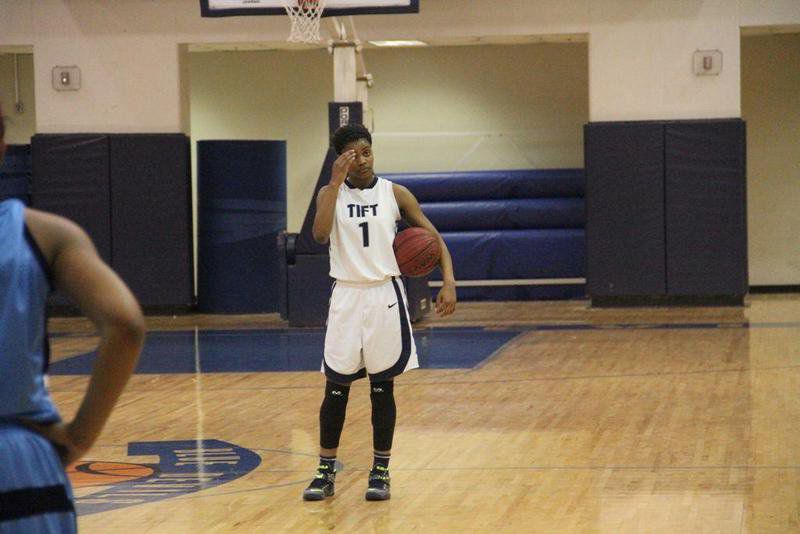Stalling Stops: Shot clock proposal passed by GHSA
Published 2:06 pm Thursday, June 25, 2020

- Becky Taylor | The Tifton GazetteThe waiting game: Audrey McElhaney brings the offense to a complete standstill. For nearly four minutes of the 4th quarter, neither team moved. The Lady Devils had crucial free throws by McElhaney and Vanity Golson to put away Lovejoy, 33-29.
THOMASTON — Big changes will be coming to Georgia high school basketball. The Georgia High School Association passed a proposal Tuesday at its spring meeting to introduce the shot clock across the state.
The 30-second shot clock will be implemented over the course of three years.
This upcoming season, 2020-21, the shot clock will be used in certain league-approved tournaments. In 2021-22, regions can choose to use the shot clock. It will be in statewide use in 2022-23.
The motion passed 53-10 according to GHSA meeting minutes published online.
The Georgia High School Association is one of the first states to vote to implement a shot clock. Fewer than 10 states now use one and the National Federation of High Schools voted against a nationwide measure in May.
A shock clock was used in 2019-20 for a handful of games at two tournaments, the Hawks-Naismith Tipoff Classic in November and the Hawks-Naismith Classic in December.
The shot clock proposal had many advocates across the state. Tift County Lady Devils head coach Julie Conner said last week that she was for its introduction. Conner has coached with a shot clock before, when she was in charge of Abraham Baldwin Agricultural College’s Fillies basketball team.
Tom Crean, University of Georgia men’s head basketball coach, was on hand Tuesday to speak in favor of introducing a high school shot clock.
On Sunday, Crean uploaded a video to Twitter explaining its benefits.
“Without a doubt in my mind, there’s no real downside to this at all,” said Crean. “Not just for the obvious reasons of the game going faster and players being more prepared for college … when you put that shot clock in, now you’ve got players that have to make quicker decisions. They have to move without the ball, they have to react quicker. They have to work with their teammates even more, they have to read situations in real time. I think it only enhances the learning process.”
Norcross head coach Jesse McMillan has had several pro-shot clock posts on Twitter in recent days. Like Crean, McMillan said that it improved the decision making process in players.
“Players must develop the ability to ‘make plays’ vs ‘run plays’ in late clock situations,” said McMillan in one of his posts.
Tuesday afternoon, McMillan’s reaction was “WE DID IT!”
After the shot clock is introduced, it will have a major effect on scoring. Gone will be the ability to stall for minutes at a time.
In 2015, Tift’s Lady Devils used this strategy in the fourth quarter against Lovejoy in the state tournament. Audrey McElhaney held the ball on her hip for 3:40 of the fourth quarter, allowing Tift to regain control of what was then a 24-22 game. The Lady Devils went on to win, 33-29.
Other notable extended stall games for the Blue Devils include a 20-15 victory over Miller County in 1951 in the region tournament, a 15-14 victory over Valdosta in 1956 and a 33-20 loss to Lanier High of Macon in 1968. Berrien overcame an Appling County stall in 1971, 27-6, as part of their state championship run.
The introduction of a shot clock is one of the biggest changes in Georgia high school basketball history, possibly the biggest since the introduction of the three-point line for the 1987-88 season.
In other GHSA spring meeting news Tuesday:
— The Board of Trustees unanimously passed the proposal for a second “dead week” on the GHSA calendar. This has been one of the goals for Tift’s Ashley Anders and the Georgia Football Coaches Association. Dead week is currently the first week of July. It will remain on the calendar. The new dead week, to be added in 2021, starts on Memorial Day.
— Cross country will no longer have area meets. All classifications will switch to region championships.
— Track teams can have only one relay team per relay event. Up to eight athletes can be listed on this team.
— Track will add a 4×800 relay event. The proposal was amended to also include the introduction of a 4×200 relay by the spring of 2022.





